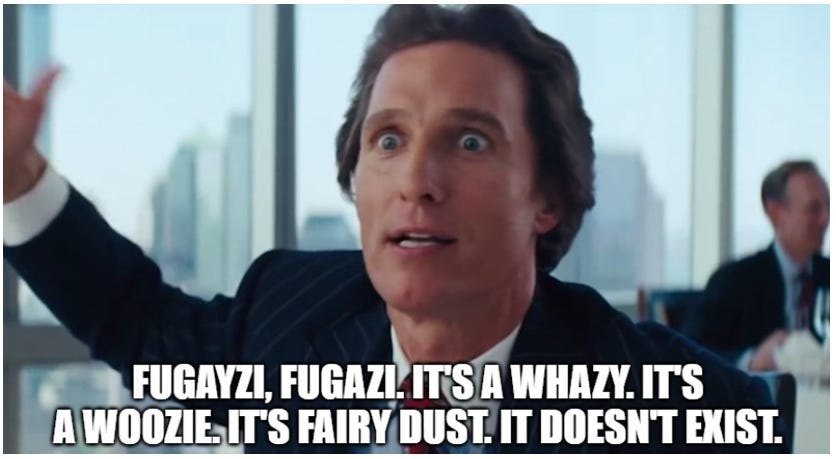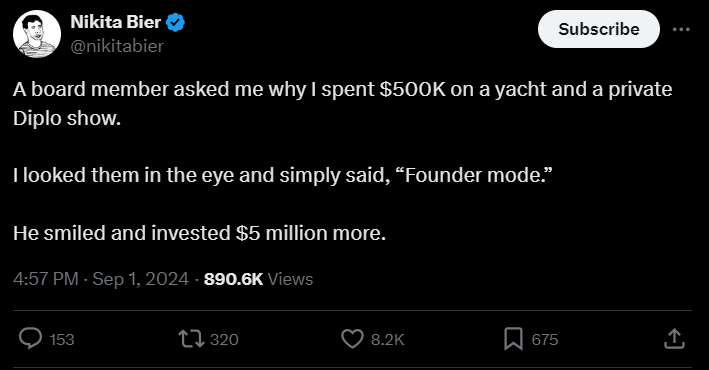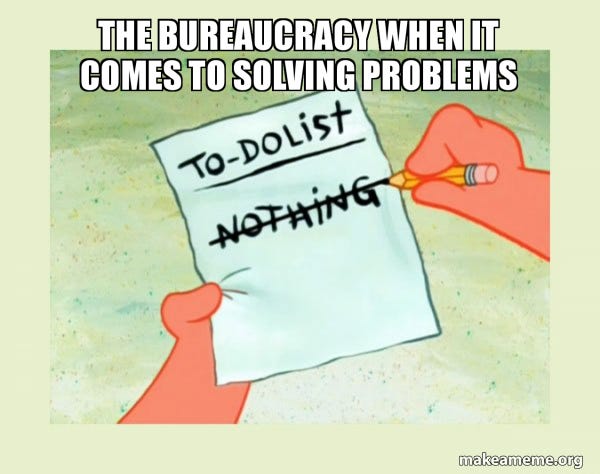“Hire good people and give them room to do their jobs. Sounds great when it's described that way, doesn't it? Except in practice, judging from the report of founder after founder, what this often turns out to mean is: hire professional fakers and let them drive the company into the ground.” Paul Graham - “Founder Mode” September 2024
While most people spent Labor day weekend enjoying the final days of summer, likely at a friends wedding, maybe hoping to secure an invite to a boat or the US open, Y Combinator (YC) Founder Paul Graham instead released the essay, Founder Mode.
Founder Mode serves as a summary and reflection on a discussion Airbnb founder Brian Chesky gave a week earlier at a YC event. The general premise of the article is that burgeoning startups are ruined when they transition from “founder mode” to “manager mode”.
The implication is that professional managers suck and ruin the magic of a quickly scaling startup. The article cites Steve Jobs as the perfect example of how Apple fell off when they replaced the founder, Jobs with a manager, John Sculley.
While the overall sentiment makes enough sense, there are a few issues with the premise and essay that I will cover in today’s article.
If this week’s article does not interest you, please check out some other recent ones:
A 1952 Satire Book Predicted ChatGPT
Sorry Jocko, Discipline is Overrated
Disclaimer: I have never started my own business, besides a nearly profitable lemon stand in the mid-90s, and I have an MBA degree, which is more of a demerit than a badge of honor in this discussion. As such, an outside observer would likely label me as a manager in this context. In any case I hope you enjoy today’s article. I also wrote this about a week ago when the takes were not as stale.
Background
After nearly two decades working with startups, Paul Graham (PG) co-founded Y Combinator as a startup accelerator in 2005. Among its first cohort was none other than Open AI CEO Sam Altman, who would eventually become President at YC in 2014. Over the years many successful startups and founders came through Y Combinator, such as Airbnb, Stripe, Coinbase, DoorDash and others, making YC the most prestigious startup accelerator in the world. While Graham reduced his day to day involvement once Altman took over, he has remained a major influence and thought leader within the global technology landscape. Beyond his mentoring of YC startups, he has achieved this through his many thoughtful essays.
Anytime PG releases a new essay, it gets widely viewed & distributed among the relevant players in the technology ecosystem. In the case of Founder Mode, Graham has seen more engagement than anything he’s done or written in years. It is not as though PG keeps a low profile either, he got into a heated Twitter feud with David Sacks from the All-in Podcast in late July.
(The December 2022 spike came from when Elon Musk suspended PG’s account for tweeting about Mastodon, shortly after Elon took over Twitter. Funnily enough, he thanks Elon among other founders at the bottom of the Founder Mode essay)
Founder Mode clearly tapped into something that forced people to pay attention. What was it?
Playing to the Crowd
“Founders feel like they're being gaslit from both sides — by the people telling them they have to run their companies like managers, and by the people working for them when they do. Usually when everyone around you disagrees with you, your default assumption should be that you're mistaken. But this is one of the rare exceptions. VCs who haven't been founders themselves don't know how founders should run companies, and C-level execs, as a class, include some of the most skillful liars in the world.”
As you might expect, the people praising the essay are largely comprised of current or former founders. PG is basically telling them that they are the superhero and if only those stupid VCs or MBA grads could get out of the way, their companies would flourish. Why wouldn’t founders want to hear that? I’m sure Lebron James likes it when his agent blames the Laker’s losses on the coach, not him.
Being Lebron James or a Founder comes with a lot of responsibility and is very difficult. Only about a quarter of venture backed startups ever return their investors capital, meaning most founders and early employees toil away for years without ever getting a major windfall. It is also true that investors and employees that join later have different motivations that are not always perfectly aligned with the founders.
As a result, there are countless examples of founders blaming the demise of their companies on board members or non-founder execs undermining their efforts. Examples of this include Parker Conrad at Zenefits (which inspired the Twitter beef with David Sacks and PG) and Sean Parker with Plaxo (the company he founded before joining Facebook). Beyond these tales of epic betrayal, the prevailing advice from VCs throughout the 90’s and early 2000’s was once a startup reached a certain scale, the founder should step aside and allow a seasoned executive to take the helm. This was the case with Eric Schmidt joining Google as CEO. The whole dynamic between VCs and startups during this time was completely different compared to today, with founders wielding far less power. Michael Lewis’ book “The New New Thing”, captures this well.
While Schmidt with Google is an example where replacing the founders with a CEO was beneficial, there many examples where founders felt it hurt the company. They attempted a similar maneuver by installing Bill Harris as CEO at PayPal, over Musk or Thiel but they quickly staged a coup and got rid of him. The employees of PayPal would then stage another coup against Elon shortly after, thus re-installing Thiel as CEO. Early PayPal days were wild (check out The PayPal Wars or The Founders).
After PayPal got acquired by eBay, Thiel would leave the company to set up several investment firms, one of them being Founders Fund; the premise being they wanted to back founders to the end. Many firms started adopting similar strategies effectively making it the standard by the 2010’s. Which is why Facebook, Snapchat, Spotify, Square and many other prominent Web 2.0 businesses went public with their original founder still on as CEO.
This is why it’s curios as to why Founder Mode is getting so much attention in 2024, when manager mode has been out of vogue for nearly two decades. In any case, it makes sense why founders hear founder mode and rejoice; PG’s advice is basically “Let Them Cook”. Founders to want to feel empowered to run their company the way they feel is best, however for every Google and PayPal story, there are many more instances where the founders are left alone but still tank the company.
What Does Founder Mode even mean?
“Indeed, another prediction I'll make about founder mode is that once we figure out what it is, we'll find that a number of individual founders were already most of the way there — except that in doing what they did they were regarded by many as eccentric or worse.”
One odd thing about the essay, is that Paul Graham doesn’t actually say what founder mode means. The above quote forms the penultimate paragraph, besides a few examples of skip levels and a few anecdotes about Steve Jobs, PG leaves that open for interpretation. If there isn’t any semblance of a consensus of how to define founder mode, it can literally mean anything (or nothing).
The essay itself doesn’t explicitly say what founder mode is but by looking at who PG thanks in the credits, we can presume what Graham had in mind. What do Brian Chesky, Patrick Collison, & Elon Musk all have in common?
Hands-on Management: All three are known to be very involved in their products development, even as their companies soared in size. Musk is known to have slept in his factories and test components by hand. They can’t be accused of kicking their feet up and delegating all the work and management to underlings.
High Expectations & Intensity: Similar to Steve Jobs, all of these founders were highly obsessed with making sure they had the best product and their operations were running as efficiently as possible. Few could last long in the high paced environments of Tesla & SpaceX.
Risk-Taking and Tolerance for Failure: None of these founders can be accused of being bean counters that follow what their investors tell them. All have taken aggressive swings into new product areas, even if they weren’t all successful. A manager mode CEOs would have played it safe.
There are likely many more but the point is, PG seems to believe that founder mode is associated to being like Steve Jobs. Take big swings, demand excellence from your team and be very hands on. The only problem is, some people interpret this advice very differently:
PG seems to be telling founders to embrace their odd or unconventional behavior; not unlike how a patron would encourage a brilliant but odd artist or genius researcher. The problem with this approach is that it works well for founders that are smart, determined and only a bit crazy but not so well when dealing with sociopaths. Weird paintings that go underappreciated in their time, don’t do as much damage as former Forbes 30 under 30 winners; just ask our friend Elisabeth Holmes above.
This is why we want to be careful about who we encourage to go founder mode and maybe define what we consider acceptable, otherwise PG will have just given justification for all types of weird behavior.
Is there a place for Manager Mode?
In the context of an early stage company, founders or executives by necessity need to be hands on. The question is, once the company starts scaling up, how should they change? The easy answer is that they need to delegate more but that does not mean they need to remove themselves entirely. If the company has a strong culture, the lower level employees will embody many of the same attributes as the founding team, but this needs to regularly be reenforced, or confusion/mission creep can set in.
On the spectrum of too much versus too little management, it’s better to air on the side of hiring dynamic people who are more autonomous, but there are limits. What good functioning companies really want, are strong player coaches, who can mentor junior employees but still work on deliverables. Problems start to arise when you have more people managing than actually doing work, they have a term for this, it’s called Bureaucracy. If your startup is starting to feel more like a government agency, you probably aren’t going to make it.
This is part of the reason why many people in startup land dislike MBAs; they assume instead of doing tangible work like sales or software development, they just want to sit back and manage others or work on “strategy”. Just adding bureaucracy. Good managers should help make the people around them better without slowing things down. If anything, good managers will help the company move faster and employees will have a better time. The only problem is, good managers that can also contribute are rare so companies often end up getting somebody technically brilliant who sucks at managing or somebody who can only manage without contributing. Unless this second type of person is an absolutely incredible manager, they are likely seen as simply adding bureaucracy and this is why PG and others hate on manager mode. These good managers still play an important role.
Let’s not ignore the achievements of non-founder executives. Frank Slootman has added hundreds of billions of dollars in shareholder value as the CEO of Data Domain, ServiceNow and Snowflake. Despite joining after the companies were already public, Shantanu Narayen and Satya Nadella were also essential in ensuring Adobe and Microsoft remain market leaders to this day. I doubt PG or other founders would simply dismiss them as manager mode leaders.
In essence, this founder vs manager mode discussion is less about if the CEO started the company and more about their willingness to take big swings and inspire their company to stay hungry and motivated as the company grows and experiences more success. Many startups can show enough traction to get through a few rounds of financing, but only a small percentage of these companies can sustain this long enough to one day IPO or become an industry leading giant. Whether your CEO is Elon Musk, Mark Zuckerberg, Tobias Lutke, Frank Slootman or John Legere, all you can hope for, is that they are unafraid to dream big and take big swings.
This is why despite the hype, Paul Graham’s essay, Founder Mode did not offer much insight to what it takes to build a great business or say anything that hasn’t been gospel in Silicon Valley for 20 years. Yet it serves as a good reminder of the risk of management creep, and the damage of soul crushing bureaucracy.
I will leave you today with this: there is no check list to decide if your somebody is a founder or manager, however if you aren’t sure if somebody’s a founder, they are likely a manager. “I shall not attempt to define the kinds of material I understand to be embraced within that shorthand description 'hard-core pornography'. But I know it when I see it.” Justice Potter Stewart - 1964 Jacobellis v. Ohio
When you see somebody in founder mode, you will know.
I hope you enjoyed today’s article. Please Subscribe or Share Some Feedback in the Comments












Nice dude - wouldn’t have found this otherwise. Great read
Great post Ben - I do agree there wasn't as much in this essay compared to PG's others, and the dissection of founder mode vs manager mode is unclear and maybe even has limited utility. Love that tweet from Nikita Bier as an aside!